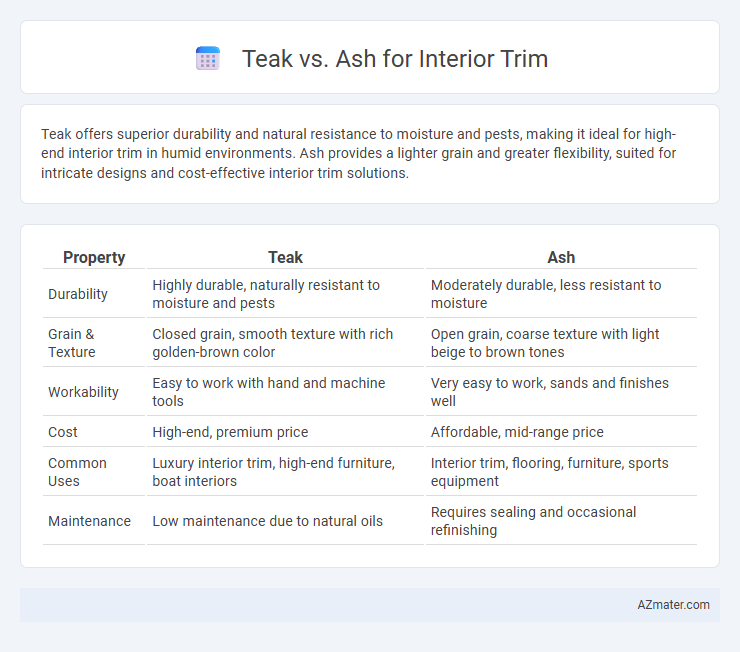Teak offers superior durability and natural resistance to moisture and pests, making it ideal for high-end interior trim in humid environments. Ash provides a lighter grain and greater flexibility, suited for intricate designs and cost-effective interior trim solutions.
Table of Comparison
| Property | Teak | Ash |
|---|---|---|
| Durability | Highly durable, naturally resistant to moisture and pests | Moderately durable, less resistant to moisture |
| Grain & Texture | Closed grain, smooth texture with rich golden-brown color | Open grain, coarse texture with light beige to brown tones |
| Workability | Easy to work with hand and machine tools | Very easy to work, sands and finishes well |
| Cost | High-end, premium price | Affordable, mid-range price |
| Common Uses | Luxury interior trim, high-end furniture, boat interiors | Interior trim, flooring, furniture, sports equipment |
| Maintenance | Low maintenance due to natural oils | Requires sealing and occasional refinishing |
Introduction to Teak and Ash for Interior Trim
Teak is a durable hardwood known for its rich golden-brown color and natural resistance to moisture, making it ideal for high-end interior trim in humid environments. Ash offers a lighter, pale beige tone with a striking grain pattern, providing a contemporary aesthetic and excellent shock resistance for interior applications. Both woods are favored for their workability and ability to take stains well, allowing versatile finishes in interior trim design.
Appearance and Grain Patterns: Teak vs Ash
Teak wood features a rich golden to medium brown hue with a straight grain pattern, often exhibiting natural oils that create a smooth, lustrous finish ideal for luxurious interior trim. Ash offers a lighter, creamy white to light brown color with a pronounced, open grain that adds a textured, rustic appeal, making it versatile for both traditional and contemporary designs. The distinctive grain characteristics in teak emphasize elegance and warmth, while ash provides a brighter, more casual aesthetic with dynamic visual interest in interior applications.
Durability and Hardness Comparison
Teak is renowned for its exceptional durability and natural resistance to moisture, insects, and decay, making it highly suitable for interior trim in high-traffic or humid areas. Ash offers considerable hardness and strength, with a Janka hardness rating around 1320, providing excellent wear resistance and impact toughness. Compared to Ash's slightly lower Janka rating of approximately 1150, Teak's hardness typically ranges from 1000 to 1150 but outperforms Ash in long-term resistance to environmental factors.
Resistance to Moisture and Decay
Teak wood exhibits exceptional resistance to moisture and decay due to its natural oils and dense grain structure, making it highly durable for interior trim in humid or variable environments. Ash, while moderately resistant to moisture, lacks the natural oils found in teak and is more susceptible to swelling and fungal decay over time. For interior trim applications requiring superior longevity and moisture resilience, teak is the preferred choice over ash.
Workability and Ease of Installation
Teak offers excellent workability due to its natural oils that enhance machinability while providing resistance to warping, making it suitable for intricate interior trim designs. Ash is known for its straight grain and smooth texture, allowing for easy cutting, sanding, and installation with minimal effort. Both woods present straightforward installation processes, but ash's lighter weight often reduces handling difficulty compared to the denser teak.
Maintenance Requirements for Teak and Ash
Teak requires minimal maintenance due to its natural oils that resist moisture, pests, and decay, making it ideal for long-lasting interior trim with occasional cleaning and oiling to preserve its rich color. Ash, while durable, demands more frequent sealing or finishing to protect against moisture and wear, as it is more prone to damage and discoloration over time without proper care. Choosing teak reduces the frequency of refinishing, whereas ash needs regular attention to maintain its appearance and structural integrity in interior settings.
Cost Differences: Teak vs Ash
Teak wood typically costs significantly more than ash due to its natural durability, rich grain, and resistance to moisture, making it a premium choice for interior trim. Ash, being more abundant and easier to source, offers a budget-friendly alternative without sacrificing strength or workability. The cost difference can vary but generally, teak may be two to three times more expensive than ash, impacting project budgets accordingly.
Sustainability and Environmental Impact
Teak and ash differ significantly in sustainability and environmental impact for interior trim applications; teak, often sourced from tropical rainforests, poses concerns due to slower growth rates and deforestation risks, while ash is commonly harvested from fast-growing temperate regions with more sustainable forestry practices. Ash wood's lower environmental footprint is enhanced by its abundance and renewable supply, making it a preferable choice for eco-conscious interior design. Choosing certified sustainably harvested ash supports responsible forest management and reduces ecological damage compared to teak.
Best Applications for Teak and Ash in Interiors
Teak excels in high-moisture areas such as bathrooms and kitchens due to its natural oil content that provides exceptional water resistance and durability. Ash, known for its striking grain patterns and light color, is ideal for living rooms and bedrooms where aesthetic appeal and moderate hardness are desired for trim and moldings. Both woods offer versatile applications, with teak suited for moisture-prone spaces and ash fitting well in dry, decorative interior settings.
Final Verdict: Choosing Between Teak and Ash
Teak offers exceptional durability and natural resistance to moisture, making it ideal for high-traffic or humid interior trim areas, while ash provides a lighter, more affordable option with prominent grain patterns that enhance aesthetic appeal. Ash's flexibility and ease of staining allow for versatile finishes, but teak's rich color and long lifespan justify its higher cost for premium projects. Final choice depends on balancing budget constraints with desired durability and design preferences for interior trim applications.

Infographic: Teak vs Ash for Interior Trim
 azmater.com
azmater.com